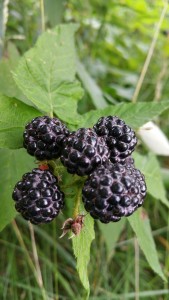Rubus occidentalis
Drought tolerant. Thorny branches provide good shelter for birds and can be planted around property edges to prevent trespassers. Edible fruit is often used in pies or preserves and can simply be
eaten raw. Dried leaves can be made into a herb tea. Attracts birds, butterflies, bees and other showy insects. Birds and mammals feed on berries.
Height : 4-6 feet
Spread : 6-8 feet
Light : Full sun to part shade
Water : Medium to moist
Soil : Sand, loam, clay
Zone : 3
Leaves : Green foliage with 3-5 per leaflets with the middle one being the largest.
Stem : Slender prickly branches that are more prominent and thorny than red raspberries
Flower : White flowers from May to June
Fruit : Delicious, edible fruit ripens in summer at a different rates creating an attractive display of red, purple and black berries. Fruit is finely hairy.
Habit : Erect arching stems that trail along the ground, spreading to form thickets and colonies. Fast growing.